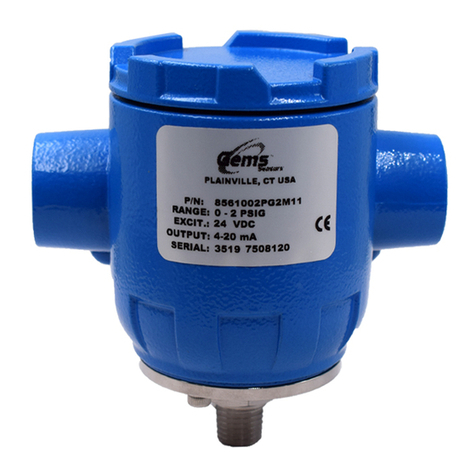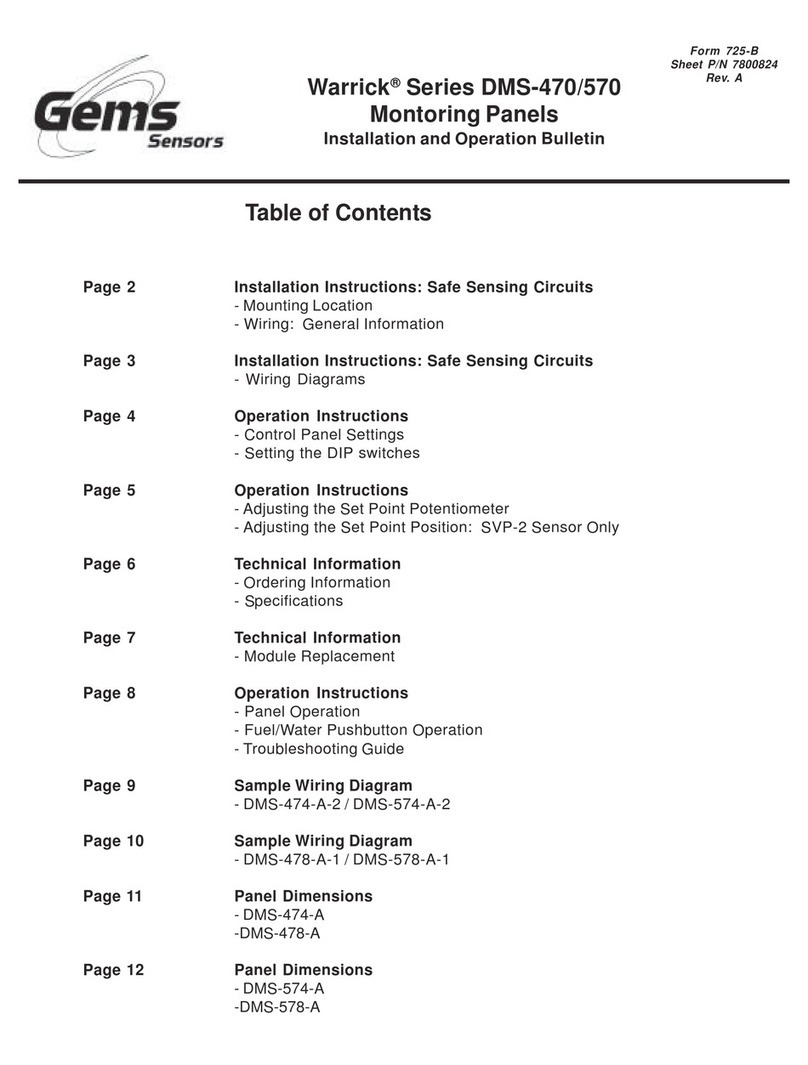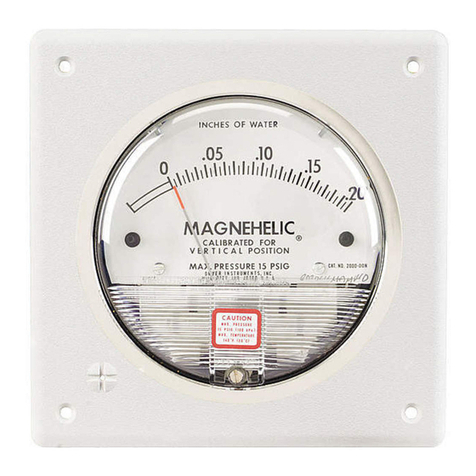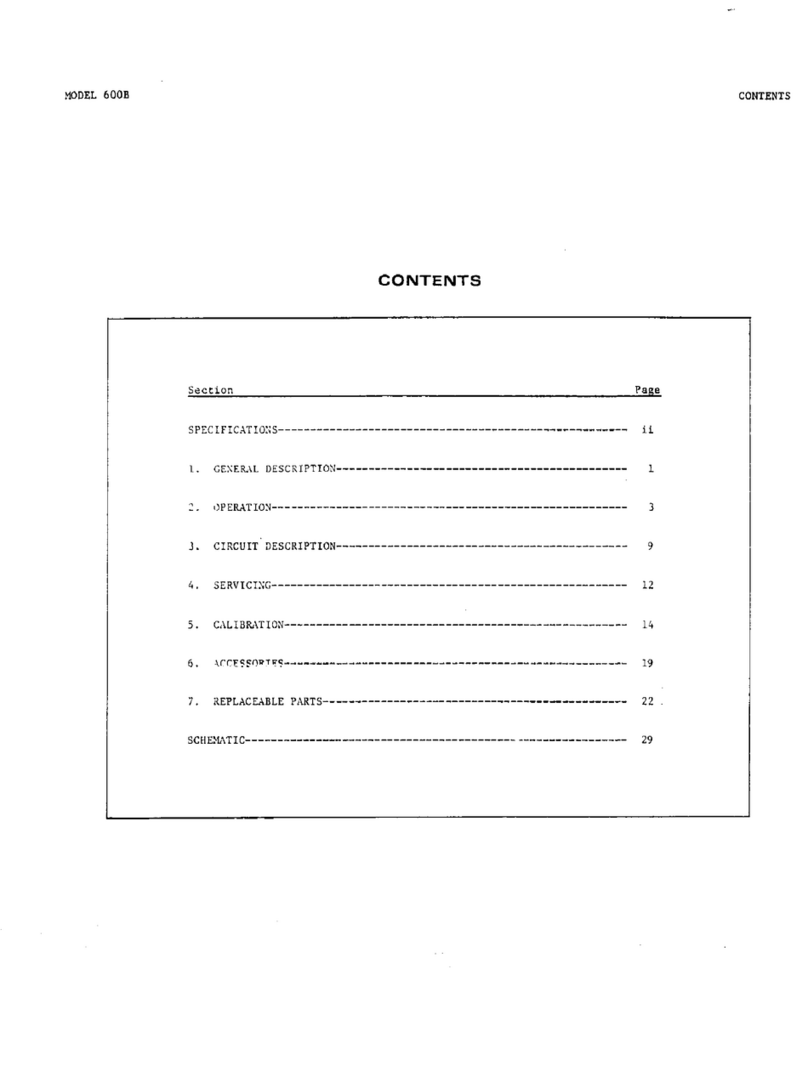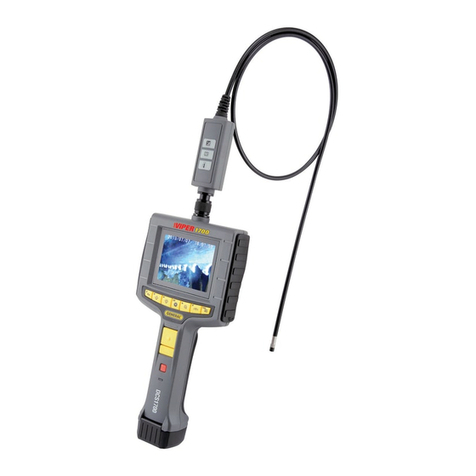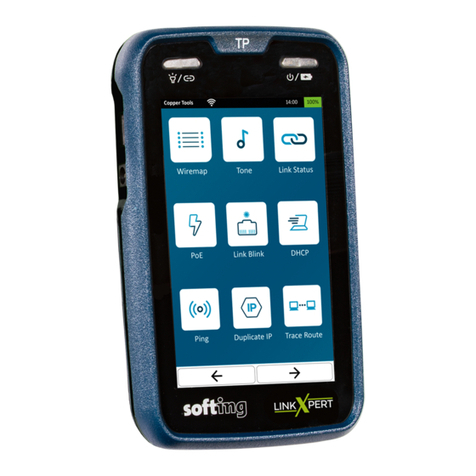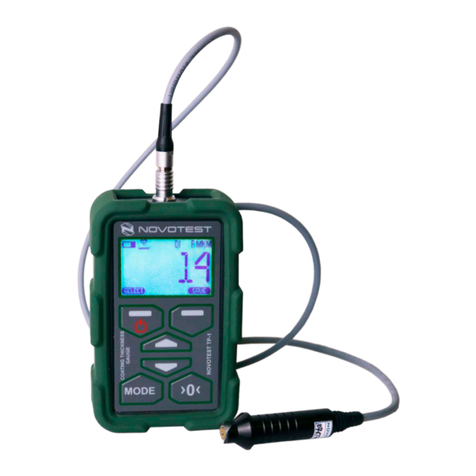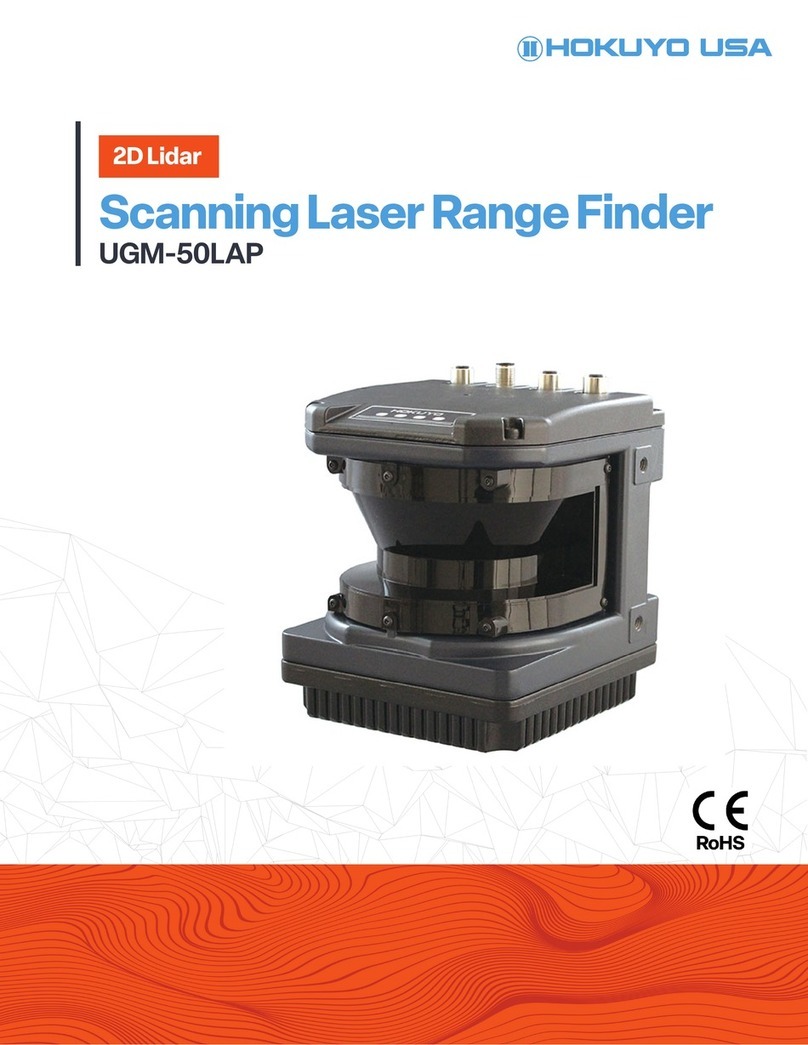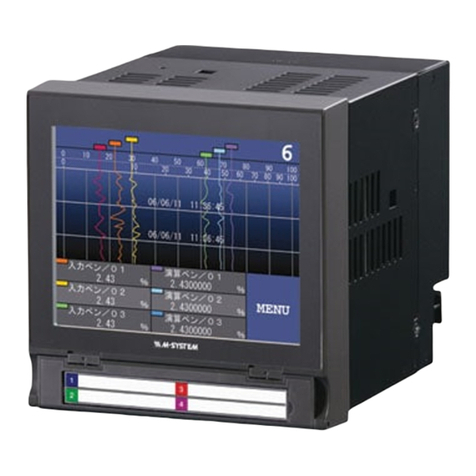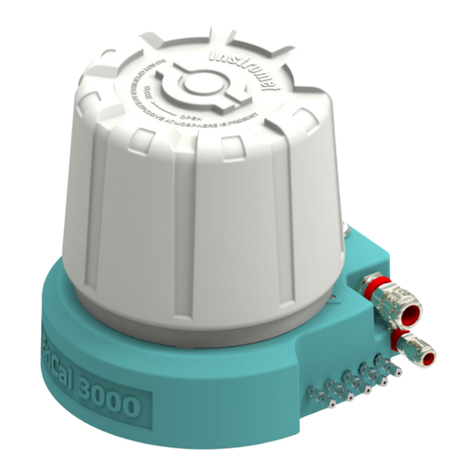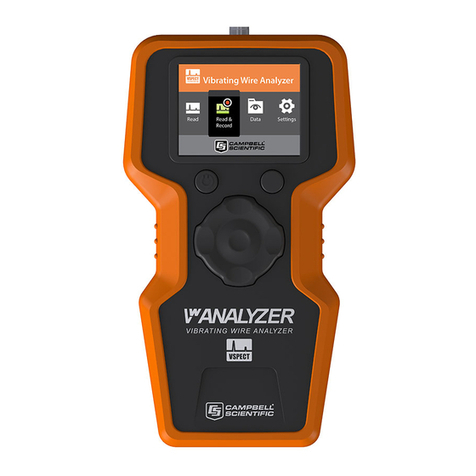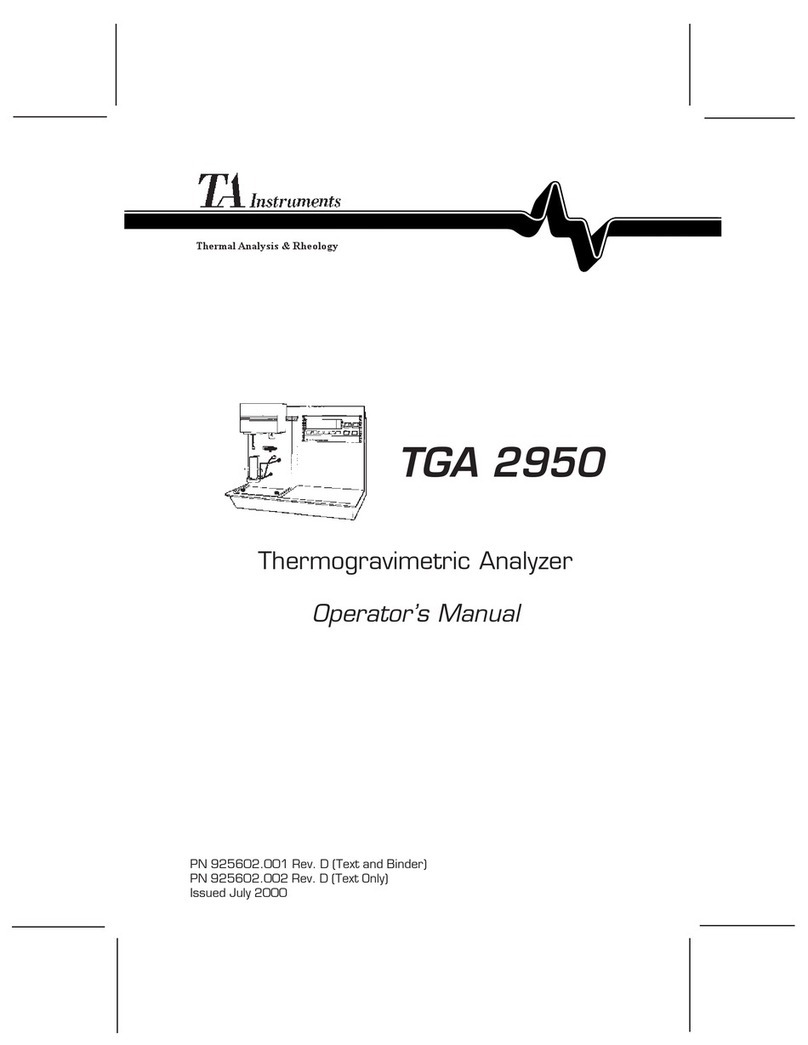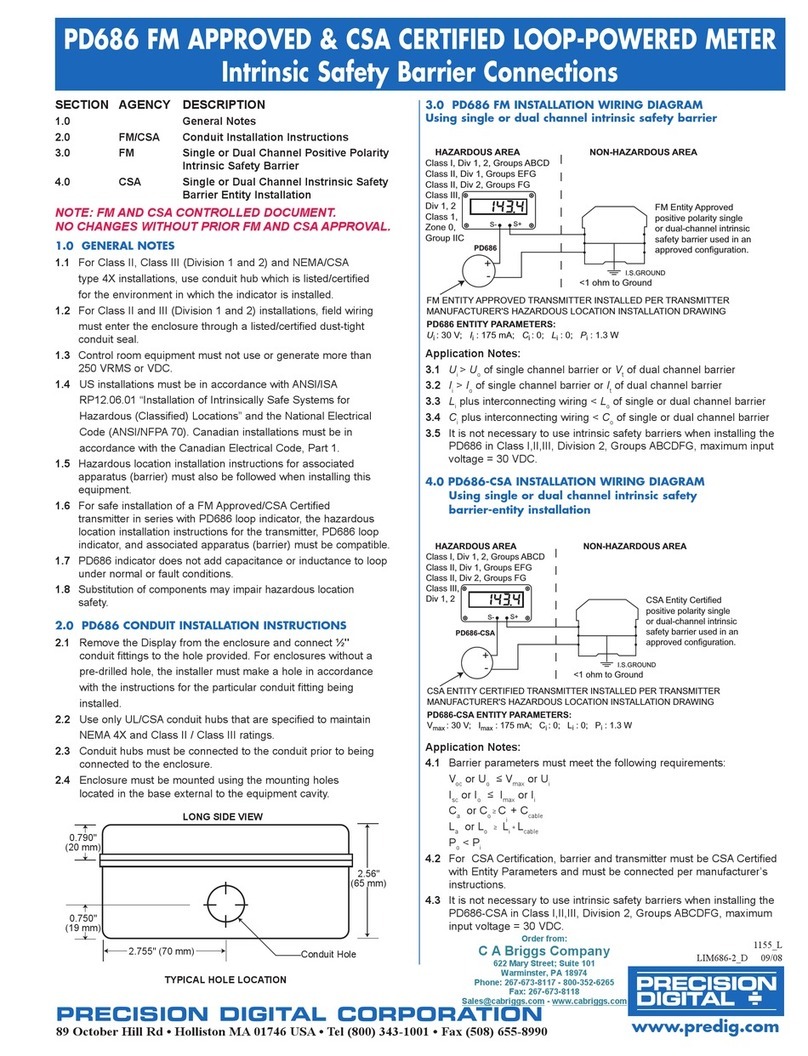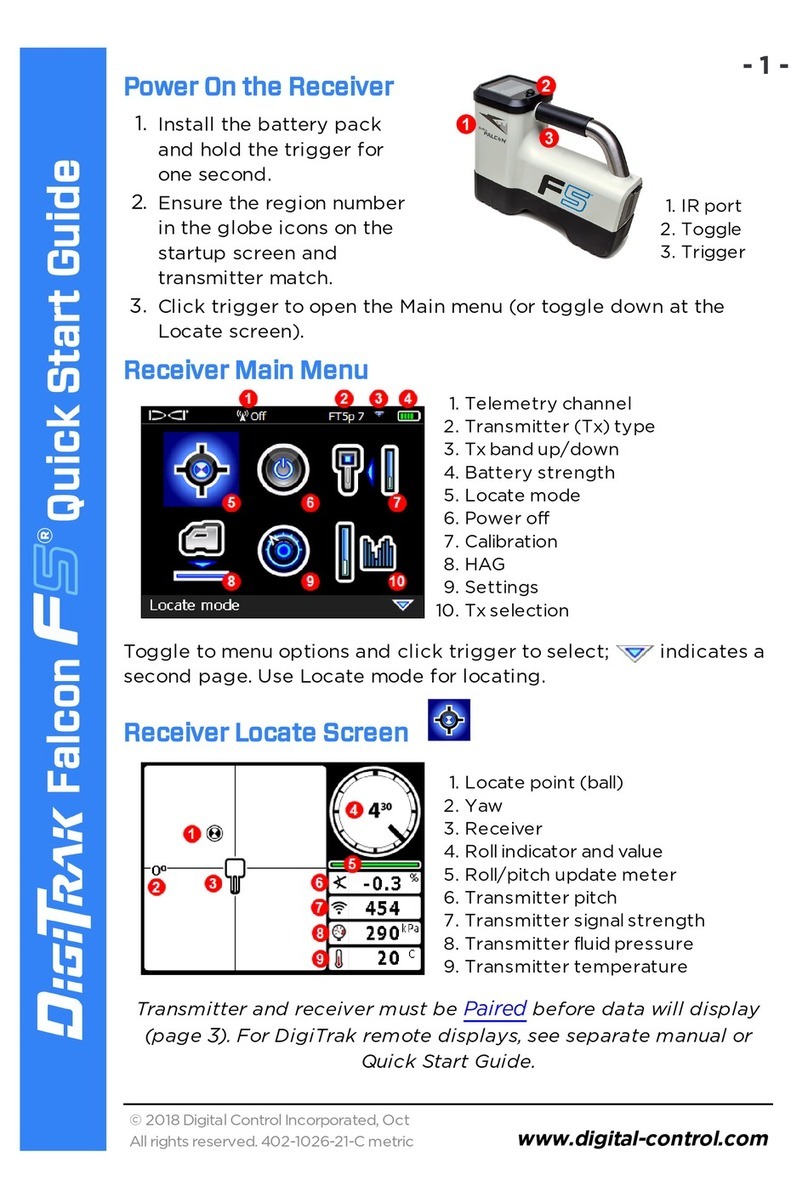Gems Sensors DM21 Series User manual

Introduction
Your Gems DM21 Rate Meter with Total is one model in a family of 1/8 DIN units
which offers breakthrough display technology as well as easy-to-program single-line
parameters. Designed to provide instant visual feedback regarding an application’s
key input value, the DM21 not only has a 0.71” high LED display (27% larger than
other 1/8 DIN units), but also the ability to change display color based on process
status (programmable parameter in Operation Mode). Easy programming is made
possible via a help function and a secondary legend display.
This manual will guide you through the installation and wiring of your DM21 unit
with information on proper panel mounting and rear terminal layout and wiring
instructions. In addition, the instrument’s operation and programming modes are
thoroughly explained. The Operation Mode provides day to day operation and
allows editing of preset values. The Program Mode enables the configuration of
various parameters prior to initial operation. These parameters include those for
basic configuration as well as other settable features which will enhance the
functionality and usability of
the device.
This manual also provides
information on the DM21
Rate Meter with Total’s
alarms; transistor, relay and
linear outputs; product
specifications; and ordering
and warranty procedures.
Index
Installation
Panel Mounting page 2
Wiring page 3
Operation
Front Panel page 4
Operation Mode page 5
Programming
Program Mode page 6-10
Appendix A
Specifications page 11
General
Ordering Information page 12
Warranty page 12
Features
• AWESOME 0.71” high digit LED display
• Programmable color change display based on
an event
• Programmable help function and secondary
legend display
• Display configurable for update time, min.
number of pulses, and forced zero time
• Optional linear output relative to rate
• Choice of NPN, PNP, or magnetic primary
input
• Filter speed settable for 20, 200, or 10,000 Hz
• Standard outputs: two NPN transistors & one
relay (optional 2nd relay)
• Front panel reset enable and alarm lockout
• Optional RS-485 plug in card
• CE approved
Technical Manual
182022
DM21-5XXXX
Rate Meter
with Total

2
INSTALLATION
PANEL MOUNTING
100mm
10mm
Mounting Grooves
The instrument can be mounted in a panel with a thickness of up to 6mm. The
cutout(s) should be made based on the recommended panel opening illustrated in the
drawing above.
Insert the unit in the panel through the cutout. Ensure that the
panel gasket is not distorted and the instrument is positioned
squarely against the panel. Slide the mounting clamp into place
on the instrument, as shown to the left, and push it forward until
it is firmly in contact with the rear face of the mounting panel and
the tabs on the bracket arm are seated in the mounting grooves
on the side of the unit.
The electronic components of the instrument can be removed from
the housing after installation without disconnecting the wiring.
To remove the components, grip the side edges of the panel and
pull the instrument forward. Take note of orientation of the unit
for subsequent replacement in the housing.
Bracket Arm
2345678
24 23 22
14 15 16 17 18 19 20
10 11 12
PGM RST
OP1
OP2
48mm
96mm
82344
PANEL
CUTOUT
SIZE
45mm
+0.5 -0.0
92mm +0.5 -0.0
Gems Sensors

3
INSTALLATION
WIRING
REAR TERMINAL CONNECTIONS
Terminals 11 & 15 are not used.
Count Inputs
Terminal #2 is the connection for Input A, which is programmable to
be the rate channel and total. Terminal #1 is the connection for
Input B, which is programmable to be an incrementing input, a
decrementing input, or channel B of encoder input. Input B cannot
be used for rate - it only serves as a secondary input for total. The
common connection for both Input A and Input B is Terminal #3.
Control/Digital Inputs
A contact closure or NPN signal can be used to activate
preconfigured functionality. Terminal # 5 is used for a remote reset
function, while Terminal #6 is a security function, that when active,
will prohibit entry into Program Mode. Termina l #8 serves
as the common for both of these inputs.
Auxiliary Power Output
A 9 - 15 VDC for powering external sensors and encoders up to 125
mA can be accessed by connecting the positive supply side of the
sensor to Terminal #4 and the negative side to Terminal #8.
Linear Output
An option board may be installed that provides a 10 bit linear output
signal relative to the Rate Value. Terminal #12 is the positive side of
the connection, and Terminal #10 is the negative side. The default
range of the output is 4-20 mA, but can be changed via the front
panel to 0-20 mA, 0-10 VDC, 2-10 VDC, 0-5 VDC, or 1-5 VDC.
Input Power
For an AC powered unit, Terminal #13 serves as the
line or Hot side connection for AC powered units and
as the positive side for DC powered units. The
neutral side for AC powered units and the negative
side for DC powered units are connected to Terminal
#14.
Transistor Outputs
Your unit comes standard with 2 NPN outputs which are activated by
each of the alarms. Transistor Output 1, which is tied to the High
Alarm Value, is on Terminal #7. Transistor Output 2, which is tied
to the Low Alarm Value, is on Terminal #9. Terminal #8 serves as
the common connection for both transistor outputs.
Relay Outputs
Your unit comes standard with a relay output which is tied to the
High Alarm Value. Terminal #19 is NC, Terminal #20 is common,
and Terminal #21 is NO. A second relay output tied to the Low
Alarm Value can be added as an option at the time of order or later
installed in the field. Terminal #22 is NC, Terminal #23 is common,
and Terminal #24 is NO.
Serial Communication
An RS-485 communication board, utilizing ASCII protocol, can be
installed as an option. Terminals #16 & #17 serve as the B and A
connections respectively, while Terminal #18 is connected as the
common.
23 4 5 6 78
24 23 22
14 15 16 17 18 19 20
10 11 12
B A COM
Power Supply
+ VDC -
RS-485 Comm.
(opt.)
Input B
Input A
Input Common
Aux. Power
(opt.)
Digital In 1
(rem. reset)
Digital In 2
(sec. lockout)
Common
+
-
Linear
Output
(opt.)
Relay 2
(opt.)
Relay 1
NPN Out 1
(HI)
NPN Out 2
(LO)

4
82345H
OP1
OP2
PGM RST
Gems Sensors
OPERATION
FRONT PANEL
Down Key Scroll Key Program Key Reset Key
Secondary Display
Output Indicators
Scroll
Down In Operation Mode: Used in edit operation to decrement
the digit highlighted by the Scroll key.
In Program Mode: Used in Edit Operation to decrement
the digit highlighted by the Scroll key, if the setting is
a numerical value, or present the next in the series of
choices for that parameter.
Program In Operation Mode: Used to move between the rate
value display, count value display, & the alarms and to
enter an edited alarm value. Holding the key down
for 3 seconds will cause the unit to enter Program
Mode.
In Program Mode: Used to move from one parameter to
the next and enter the edited parameter values.
Holding the key down for 3 seconds will cause the
unit to return to Operation Mode.
In All modes: Moves the unit into Edit Operation,
which is indicated by the left most digit flashing.
Successive presses of the key are used to move to the
digit to be edited. Wrap around will occur from least
significant digit to most significant digit.
Reset In Operation Mode: Resets the Count Values to zero.
This button can be disabled via the "Front Panel Reset
Enable" parameter in Program Mode.
In All modes: No function.
In All modes: Will abort an Edit Operation and return
the alarm/parameter to its previous value.
Down &
Scroll
together
Key
Primary In Operation Mode: Default display is the rate value.
Can be scrolled using the program key to display the
count value and alarm values. If the "Help" function is
enabled, this display will first show the parameter
description for 3 seconds (see page 5 for example).
In Program Mode: Displays the value or selection for
the current parameter. If the "Help" function is
enabled, this display will first show the parameter
description for 3 seconds (see page 6 for example).
Secondary In Operation Mode: Indicates alphabetically which
parameter is being viewed on the primary display.
In Program Mode: Provides a 1 digit alpha or numeric
character to indicate which parameter value is being
shown on the primary display.
Output
Indicators
In Operation Mode: OP1 illuminates when Output 1 is
active. OP2 illuminates when Output 2 is active.
In Program Mode: No function.
Display Functions
Key Functions
Function Display Function
Primary Display

5
PGM RST
OP1
OP2
PGM RST
OP1
OP2
PGM RST
OP1
OP2
PGM RST
OP1
OP2
PGM RST
OP1
OP2
PGM RST
OP1
OP2
PGM RST
OP1
OP2
OPERATION
OPERATION MODE
CHANGING A PARAMETER VALUE
* Parameter descriptions will not
appear on the primary display if the
"Help" function has been disabled.
PGM
PGM
PGM
Default display is the rate value.
Pressing the Program Key will cause the
display description to appear on the
main display.* If there is no key activity
for 3 seconds, the primary display will
switch back to the rate value.
Continued pressing of the Program Key
will scroll through the Parameters. (See
Parameter Sequence below.) The full
parameter description will appear on the
main display.*
To change a Parameter value, press the
Scroll Key. If there was no key activity
for 3 seconds, the Preset value will
appear (one digit description shown on
secondary display); however, press the
Scroll Key in order to edit. The unit will
now be in Edit Operation as signified by
the most significant digit flashing.**
Use the Scroll Key to move from left to
right and highlight the digit that needs
to be changed. Wrap around will occur
from the least significant to the most
significant digit.
Use the Down Key to decrement the
digit until the desired value appears.
The display will wrap around from 0 to
9.
After the desired digits have been
changed, press the Program Key to enter
the new value. The new value will
appear on the main display without any
flashing digits. Press the Progam Key
again and the parameter description will
appear on the main display.
23456
Hi AL
rAtE
H
34567
H34567
H
33567
Hi AL
PGM
** Edit Operation cannot be
accessed if the Preset Lock has
been enabled in Program Mode.
PARAMETER SEQUENCE
rAtE Rate Value
Function: Displays present rate value
Range: 0 to 99999
PGM
Count Value
Function: Displays present count time
Range: 0 to 99999
PGM
Count C
High Alarm Value
Function: Defines the rate or count value
at or above which Alarm 1 will activate
Adjustment Range: 0 to 99999
Default Value: 1000
PGM
Low Alarm Value
Function: Defines the rate or count value
at or below which Alarm 2 will activate
Adjustment Range: 0 to 99999
Default Value: 10
L
H
rHi AL
Lo AL
Gems Sensors
Gems Sensors
Gems Sensors
Gems Sensors
Gems Sensors
Gems Sensors
Gems Sensors

6
PGM RST
OP1
OP2
PGM RST
OP1
OP2
PGM RST
OP1
OP2
PGM RST
OP1
OP2
PROGRAMMING
PROGRAM MODE
ENTERING PROGRAM MODE AND BASIC OPERATION
PARAMETER SEQUENCE
PGM
PGM
PGM
for 3 seconds
The name of the first parameter will appear
on the primary display.*
Pressing the Scroll Key or no key activity for
3 seconds will display the value for that
parameter. The secondary display will
indicate the one digit identifier for the
parameter. The digit in the secondary
display will flash to indicate the unit is in
Program Mode. If the Scroll Key was
pressed (instead of waiting 3 seconds), the
unit is in Edit Operation, as indicated by the
MSD flashing. If there had been no key
activity for 3 seconds, press the scroll key to
enter Edit Operation (MSD flashing). Use
the scroll and edit buttons to change the
value as in Operation Mode, described on
page 5. Press the Program Key to enter any
changes.
Successive presses of the Program Key will
scroll the display through the remaining
parameters in the Program Mode. To exit
Program Mode, hold the Program Key for 3
seconds.
The Program Mode can be accessed from the
Operation Mode by holding the Program Key
for 3 seconds.
* Parameter names will not appear on the
main display if the "Help" function has been
disabled in Program Mode.
cCAL Count Calibration Factor
Function: Used to scale the input into engineering units by multiplying this value by the number of pulses
received
Adjustment Range: 0.0001 to 9.9999
Default Value: 1.0000
PGM
23456
cCAL C
1..0000
dEc P
Edit Operation
C
dEc Pd
Decimal Position
Function: Set the decimal point position for the count display
Adjustment Range: 0 to 0.0000
Default Value: 0
PGM
no key activity
for 3 secs. or
Gems Sensors
Gems Sensors Gems Sensors
Gems Sensors

7
PROGRAMMING
PROGRAM MODE Continued
rCALP r
Rate Calibration Factor Decimal Point
Function: Sets the decimal point position for the rate calibration factor display
Adjustment Range: 0 to 0.0000
Default Value: 0
c
count Count Mode
Function: Defines how the input pulses will be applied to the count value
Adjustment Range:
dir
A+B: Inputs on both the
A & B channels
increment the total
Directional: When input
B is inactive, input A
increments. When input
B is active, input A
decrements
A+- A-
A-B: Inputs on the A
channel increment the
total, while inputs on the
B channel decrement
Default Value: A+B
PGM
Input Type
Function: Programs the unit to match the electrical characteristics of the input signal
Adjustment Range:
i
1nPut
Sinking: The unit will
accept a NPN or dry
contact input which sinks
voltage to common
Sin Src
Source: The unit will
accept an PNP input
which sources voltage
PGM
Default Value: Sinking
PGM
<>AG
Magnetic: The unit will
accept a magnetic input
from 0.5 to 30V peak
rCAL Rate Calibration Factor
Function: Used to scale the input into engineering units by multiplying this value by the input frequency
Adjustment Range: 0.0001 to 99999
Default Value: 1
PGM
rdEc E
Rate Decimal Point Position
Function: Sets the decimal point position for the rate display
Adjustment Range: 0 to 0.0000
Default Value: 0.0
PGM
r
.
bb QuAd
Quadrature: The unit
accepts a phased input
from an encoder. The
total increments when the
A channel leads the B
channel

8
PROGRAMMING
PROGRAM MODE Continued
P
Minimum Pulses
Function: Sets the minimum number of pulses to be received before the display will update the rate value.
Note: Display Update Time and Minimum Pulses must be realized before the display will update.
Adjustment Range: 1 to 99
Default Value: 1 0
PulS
PGM
S
Startup Suppression
Function: Determines the delay period that will occur after power-up before alarm operation is possible
Adjustment Range: 0 to 99 secs.
Default Value: 0
Strt
PGM
U
uPdAt Display Update Time
Function: Sets the amount of time between display updates
Adjustment Range:
0.1 0.25 0.5 1
0.1 sec. 0.25 sec. 0.5 sec. 1 to 10 sec.
Default Value: 1
PGM
to 1 0
0
0Display to Zero Time
Function: Displays minimum input frequency by setting the amount of time after no pulses are received, when
the display will show zero
Adjustment Range:
0.1 0.25 0.5 1
0.1 sec.
(10 Hz.)
0.25 sec.
(4 Hz.)
0.5 sec.
(2 Hz.)
1 to 10 sec.
(1 Hz. to 0.1 Hz.)
Default Value: 1
PGM
to 1 0
ti
Filter Speed
Function:
Enables the debounce filter of the meter to properly match the application
Adjustment Range:
F
SPEEd
20: The unit will accept up to 20
pulses per second. Generally
used with contact inputs to
eliminate false counts caused by
contact bounce
20 200
200: The unit will accept up to
200 pulses per second. Generally
used for higher speed contact
inputs or to filter noise on
electronic signals in low speed
applications
10000
10,000: The unit will accept up
to 10,000 pulses per second.
Generally used with high speed
electronic inputs and encoders
Default Value: 10000
PGM

9
PROGRAMMING
PROGRAM MODE Continued
r
Front Panel Reset Enable
Function: Determines whether the Front Panel Reset key can be used to reset the rate value
Adjustment Range:
rS En
Enable: The rate value can be reset
while being viewed in Operation Mode by
pressing the Front Panel Reset Key
En diS
Disabled: The Front Panel Reset Key is
disabled and the rate value can only be
reset through the Remote Reset Input
Default Value: Enable
PGM
c
Serial Communication Enabled
Function: Activates the RS-485 communication option board
Adjustment Range:
Co<>S
None: No communication
board installed
nonE Fit
Default Value: If ordered from the factory with the RS-485 board, the default will be "fitted". If the board is
installed in the field, this parameter will need to be changed from its default of "none"
Fitted: A communication
board is installed in the
unit
PGM
t
Retransmission Enable/Select
Function: Determines whether a voltage/current is an output, and if so, which range
Adjustment Range:
nonE 0-5u 0-10u 0-20A
None 0-5 Volts 0-10 Volts 0-20 mA
Default Value: None
PGM
rt En
4-20A
4-20 mA
L
Retransmission Scale Minimum
(Appears only if a current/voltage is selected)
Function: Defines the lower end of the linear scale for the retransmission output by defining the value equated
to the minimum output signal - i.e. for a 4-20 mA output, this would be the value corresponding to 4 mA
Adjustment Range: 0 to 99999
Default Value: 0
PGM
rt Lo
H
Retransmission Scale Maximum
(Appears only if a current/voltage is selected)
Function: Defines the lower end of the linear scale for the retransmission output by defining the value equated
to the minimum output signal - i.e. for a 4-20 mA output, this would be the value corresponding to 20 mA
Adjustment Range: 0 to 99999
Default Value: 100
PGM
rt Hi

10
PROGRAMMING
PROGRAM MODE Continued
Preset Lock
Function: Determines whether the Preset Values can be changed via the front panel
Adjustment Range:
Enable: Preset values are read only
En diS
Disabled: Preset values can be viewed and
changed
Default Value: Disable
PGM
Help Prompt
Function: Determines whether the multi-character parameter name will appear on the main display for 3
seconds prior to the parameter value appearing
Adjustment Range:
HELP h
Help - Yes: Multi-character parameter descriptions
will appear on the primary display. The value
associated with that parameter will appear by
pressing the scroll key or waiting for 3 seconds
HLP Y
Help - No: Only the parameter values will appear on
the primary display. The parameter can be identified
by a single digit in the secondary display
HLP N
Default Value: Help - Yes
Loc/ /
b
bAud Baud Rate
(Appears only if communication board is installed and activated)
Function: Selects the serial communication speed
Adjustment Range:
1200 2400 4800 9600
1200 BPS 2400 BPS 4800 BPS 9600 BPS
Default Value: 4800
PGM
o
Color Display Color Change
Function: Defines the color of the display for prior to and after the preset value is reached
Adjustment Range:
rEd GrEEn Gn_rd rd_Gn
Green to Red: The
display will be green prior
to the Alarm value being
reached. It will turn red
after the Alarm has been
reached
Red to Green: The
display will be red prior to
the Alarm value being
reached. It will turn green
after the Alarm has been
reached
Default Value: Green to Red
PGM
A
Communication Address
(Appears only if communication board is installed and activated)
Function: Defines the unique communication address of the counter
Adjustment Range: 1 to 99
Default Value: 1
Addr
PGM

11
APPENDIX A
SPECIFICATIONS
Count Inputs
Type: Sinking/Sourcing or Contact Closure
Frequency: 10 kHz max.
Logic: Low < 2.0 VDC, High > 3.0, 30V max.
Impedance: 10 KΩto common - Sourcing
4.7 KΩto +Voltage - Sinking
Magnetic Input: 0.6 to 30V peak
Control Inputs
Type: Sinking, Edge Sensitive
Logic: Low < 2.0 VDC, High > 3.0
Impedance: 4.7 KΩto +Voltage
Response Time: 25 ms
Function: Input 1: Remote Reset
Input 2: Security Lockout
Outputs
Solid State: NPN open collector, 30 VDC max, 100 mA max.
Relay: SPDT, 5A resistive @ 110VAC
Latency: 75 µseconds, plus 8 ms for relay pull-in
Linear Outputs
Ranges: 0-20mA, 4-20mA, 0-10V, 2-10V, 0-5V, 1-5V
Accuracy: ±0.25% (mA at 250Ω, V at 2kΩ);
degrades linearly to ±0.5%
Resolution: 8 bits in 250ms (10 bits in 1s typ.)
Update: Approximately 4/s
Load Impedence: mA Ranges: 500Ωmax.; V Ranges: 500Ωmin.
Approvals
General: CE
EMC Susceptibility: Complies with EN50082-1: 1992,
EN50082-2: 1995
EMC Emissions: Complies with EN50081-1: 1992,
EN50081-2: 1994
Safety: Complies with EN61010-1: 1993
Communication
Type: Serial asynchronous, UART to UART
Data Format: Open ASCII: One start bit, even parity seven
data bits, one stop bit
Physical Layer: RS-485
Maximum Zones: 99
Baud Rate: Selectable from 9600, 4800, 2400, or 1200
Electrical
Supply Voltage: 90-264 VAC, 50/60 Hz, or 20-50 VAC/VDC
Power Consumption: 4 Watts
Access. Power Supply:9-15 (unregulated VDC), 125 mA max.
Display
Type: Red/Green, 7 segment LED, 5 digits primary
display, single digit secondary display
Height: 0.71" (18mm) primary display,
0.3" (7mm) secondary display
Annunciators: Output 1 & 2 status
Physical
Dimensions: 48mm x 96mm, 110mm deep
Mounting: Panel mount (mounting bracket supplied),
45mm x 92mm cutout
Terminals: Screw type - combination head
Front Panel Rating: NEMA 4X/IEC IP65
Case Material: GE Lexan 940
Weight: 0.56 lbs.
Environmental
Operating Temp.: 0°to 55°Celsius, 32°to 131°Fahrenheit
Storage Temp.: -20°to 80°Celsius, -4°to 176°Fahrenheit
Relative Humidity: 20% to 95% non-condensing

12
WARRANTY
GENERAL
ORDERING INFORMATION
Linear Output
Option
0None
3Linear Output
DM21 - 5
2nd Relay Option
0None
12nd Relay
Serial Communication
Option
0None
5RS-485
Power Supply
090-264 VAC
220-50 VAC/VDC
Additional outputs and options can be
field installed through plug-in boards
which can be ordered separately.
Description Part #
Relay Board T50-001
DC Linear Board T50-003
RS-485 Comm. Board T50-005
Gems Sensors Inc., the seller, warrants its products to be free from defects in material and workmanship in normal use and service for a
period of one year from date of shipment. Gems reserves the right and option to refund the purchase price in lieu of repari or
replacement upon evaluation of the returned original part. Modification, misuse, attempted repair by others, improper installation or
operaiton shall render this guarantee null and void. Gems Sensors Inc. makes no warranty of merchantability or fitness for a part or
purpose.
Limits of Liability
In no circumstances shall Gems Sensors Inc. be liable for special, consequential or exemplary damages of any kind or character,
including contract tort, and strictly liability in tort and contract.
Equipment sold by Gems Sensors Inc. is not intended for use in a nuclear installation, nor shall it be used as a "Basic Component" as
same as deined under Part 21, Title 10 of the Code of Federal Regulations. In the event of such use, you agree to indemnify and hold us
harmless from any and all subsequent liabilities and responsibilities which might arise in connection with such use.
Returning Goods
Contact your local sales agent or the factories for return policy prior to sending back any product.
#182022
Revision: none
Gems Sensors Ltd.
Lennox Road
Basingstoke
Hants, RG22 4AW
Phone: +44 (0) 1256.320244
Fax: +44 (0) 1256.473680
Gems Sensors Inc.
1 Cowles Road
Plainville, CT 06062
USA
Phone: +001 (1) 860.747.3000
Fax: +001 (1) 860.747.4244
Table of contents
Other Gems Sensors Measuring Instrument manuals
